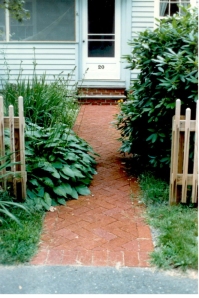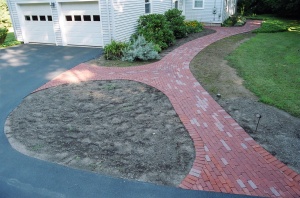If you’ve ever walked through a landscape and not been able to tell what part of the country you were in, or have traveled somewhere only to find the same plants, paving materials, and stores as the mall back home, then you have experienced the homogenization of today’s society. Uniqueness is giving way to mass production in our world. If everywhere we go, looks the same as where we’ve been, is there really any reason to have gone there in the first place? This post, and the posts of 12 of my friends and fellow Landscape Designers today, is dedicated to celebrating regional diversity in the garden. Lauding the uniqueness of each corner of this small planet. Please take some time to visit the other participants blogs, and experience the visions of each of these talented designers, as they delve into regional diversity in Garden Design. You’ll find their names and links to their blogs at the end of this post.

I live and design landscapes in southern New England. New England is a wonderfully diverse region of the country. The Connecticut River Valley, rich and fertile, has been home to thriving agriculture for some 400 years. Dairy farms once dominated the rolling hills of Vermont. There are granite quarries in New Hampshire, brownstone quarries in Connecticut, rocky lobster beds in Maine, and the world’s premier oyster fisheries in Long Island Sound. Mill towns throughout the region stand as reminders of a strong manufacturing base, long since weakened by present day global economies. Ecosystems vary from huge sand dunes on Cape Cod, alpine meadows in New Hampshire, deep spruce forests in Maine, and over 6000 miles of rocky and sandy coastline. In a days drive, one can experience all that New England has to offer, passing through cattle pastures, tobacco fields, mountain passes, large cities and industrial hubs.

The architecture in New England is predominantly colonial in nature. It echoes the feel of northern Europe, for it is those Europeans that originally settled here. They brought with them their colonial style houses, cottage gardens, and an innate ability to construct miles and miles of field stone walls, perhaps the defining image of New England. Stone walls line both farmland and Main Street in most New England towns, and that same stone can be found in the construction of many of the older factories, churches and municipal buildings.
Sadly though, New England’s natural beauty is slowly disappearing, succumbing to strip malls and boring landscapes of mass produced plant cultivars. The brick paths, field stone walls and cottage gardens, that provided this region with its traditional character and charm, are also giving way to more modern concrete pavers, block walls and uninteresting plantings. To turn around this trend, one need only to look again to New England’s history and natural beauty when designing a garden. Its early European influences, natural geography and native ecosystems, still present today, can easily be drawn upon to marry each design to the regions character. And when that design is true to its surroundings, and successfully implemented, the effort put forth to enhance that natural beauty, disappears beneath a conjoined sense of place. To put it simply, a well designed landscape seems not to have been designed at all, yet gives the visitor a sense of location, and of the character within. Herein lays the value of celebrating a location’s natural diversity, and turning away from homogeneous design. By focusing on regionally specific plant groups, hardscape materials, and design concepts, we promote uniqueness rather than assimilation into the global fold.

Examples that might celebrate regional diversity could be as follows: A shade garden of locally native plants beneath a beautiful hardwood canopy, so common in New England, instead of cutting down as many trees as possible to grow a lawn. A meadow or rain garden in a low lying damp area, filtering toxins from runoff before it reenters the ecosystem. A habitat garden comprised of native plant species providing a place of food and sanctuary for the native fauna. Moving in closer to the house, examples might include; Native stone and brick to construct walkways and patios, calling back to the days when such materials were quarried in a nearby location. Regionally available wood species, felled and milled locally to build garden structures. And, when possible, situating the home itself so as to accentuate the property, shunning cut and fill grading practices and taking advantage of the land’s unique characteristics.

Drawing upon the history, native plants and hardscape materials of a region when designing a project, provides the designer a culturally specific path to creating that garden. A garden that celebrates its location and informs its visitors. As our world continues to shrink, it is imperative to preserve local character and regional identity. Doing so, will give your garden its unique sense of place.
I hope you find yourself a new sense of place in your own garden. And please, if you any thoughts on this topic? I’d love to hear them, leave a comment below!
Scott
I would invite you now to visit my friends and fellow Landscape designers as they blog from their unique and diverse regions, and who knows, maybe you’ll find an interesting place to visit the next time you venture across this wonderfully diverse country of ours. Click on each of the Designers names to visit their blogs. (And while your there, explore some of their older posts also. You’ll find a wealth of information!)
Jocelyn Chilvers (The Art Garden) – Wheat Ridge, CO
Susan Cohan (Miss Rumphius’ Rules) – Chatham, NJ
Michelle Derviss (Garden Porn) – Novato, CA
Tara Dilliard (Landscape Design Decorating Styling) – Stone Mountain, GA
Dan Eskelson (Clearwater Landscapes Garden Journal) – Priest River, ID
Laura Livengood Schaub (Interleafings) – San Jose CA
Susan Morrison (Blue Planet Garden Blog) – East Bay, CA
Pam Penick (Digging) – Austin, TX
Susan Schlenger (Landscape Design Viewpoint) – Charlottesville, VA
Genevieve Schmidt (North Coast Gardening) – Arcata, CA
Ivette Soler (The Germinatrix) – Los Angeles, CA
Rebecca Sweet (Gossip in the Garden) – Los Altos, CA
Become a Fan of Blue Heron Landscape Design on Face book – http://bit.ly/yq1XT
Follow me on Twitter: http://twitter.com/ScottHokunson
Connect with me on LinkedIn: http://www.linkedin.com/in/scotthokunson
